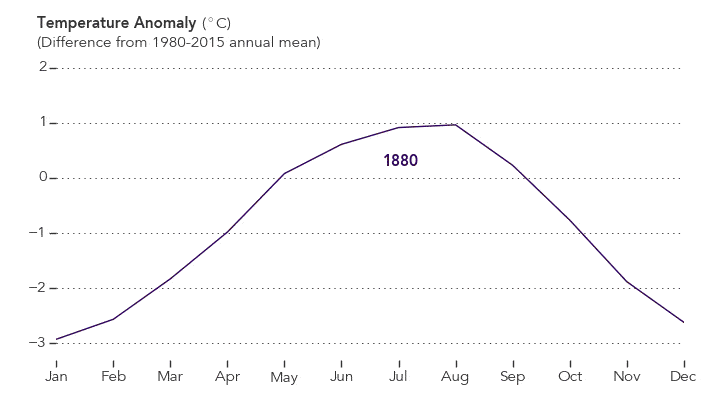The Earth continues to heat up according to a NASA analysis that revealed 2017 was the second warmest year since global estimates became possible in 1880. More worryingly, it was only second to 2016, which saw increases in temperature caused by El Niño, the warm phase of the cyclical El Niño Southern Oscillation (ENSO). When correcting for the phenomenon, 2017 takes the lead.

The year continued the ignoble, decades-long warming trend of the globe — 17 out of the 18 warmest years on record have occurred between 2001 and today. NASA’s Goddard Institute for Space Studies (GISS) reports that globally-averaged temperatures in 2017 were 1.6° Fahrenheit higher than the 1951-1980 mean.
It came second as the warmest-ever recorded year behind 2016. However, temperatures then were bumped up by El Niño, which pushes warmer fronts of water from the western tropical Pacific Ocean towards the coast of South America. This movement of warm water causes warming effects across the globe.
When El Niño is factored out, 2017 becomes the warmest year ever recorded by humanity.
2016, bolstered by El Niño, still holds the record for the warmest year. The warmer water in the tropical Pacific Ocean during an El Niño can cause warming effects around the globe. 2017 was the warmest year without an El Niño. pic.twitter.com/Vng9bWGVV8
— NASA GISS (@NASAGISS) January 18, 2018
The Earth warmed up overall, but weather dynamics mean that this effect wasn’t homogenous across the face of the planet — as such, different locations experienced different amounts of warming.
“Despite colder than average temperatures in any one part of the world, temperatures over the planet as a whole continue the rapid warming trend we’ve seen over the last 40 years,” said GISS Director Gavin Schmidt.
The strongest warming trends were seen in the Arctics, which continued to bleed ice cover and volume in 2017, the report adds.
National Oceanic and Atmospheric Administration (NOAA) researchers produced an independent analysis on the subject, which strongly confirms NASA’s findings, with the exception that NOAA lists 2017 as the third warmest year on record.
The two agencies used different methods to analyze temperatures across the globe, which created this small difference in ranking. NASA tracks temperatures using a combination of data from 6,300 weather stations, ship- and buoy-based recordings of sea-surface temperatures, as well as research stations in the Antarctic. The algorithm that data is fed through was designed to consider sources of interference to produce the global average temperature deviations from the baseline period of 1951 to 1980, according to NASA.
This processing (and the fact that NOAA uses its own algorithms) is why the two agencies’ results diverge slightly. However, the findings reported in both documents largely overlap, and both agree that the five warmest years on record have taken place since 2010.

Image credits NASA.
“NOAA scientists used much of the same raw temperature data, but with a different baseline period, and different methods to analyze Earth’s polar regions and global temperatures,” the NASA report reads.
NASA estimates that the global mean change in temperature they calculated is accurate within 0.1°F with a 95% certainty level — which is very solid. Any uncertainty arises due to changes in measurement practices over time, and to some weather stations being relocated over the studied period.


